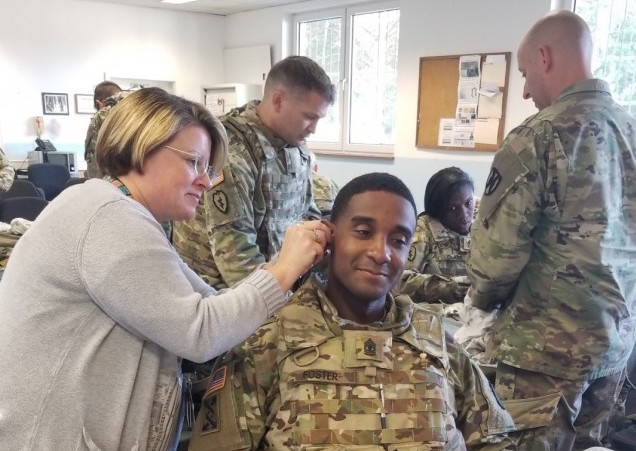Researchers from the US Army Aeromedical Research Laboratory have used 3D printing to produce and test customizable earplugs for members of the US Armed Forces.
The army scientists’ new technique for producing ear protection, could be deployed to prevent hearing loss among members of the armed forces. Damage to soldiers’ hearing can cause them to become more vulnerable and lose combat readiness on the battlefield, in addition to limiting their ability to take part in social interactions.

Additive manufactured earplugs
It’s currently mandatory for soldiers to wear some kind of Hearing Protection Device (HPD), and those that are routinely exposed to hazardous noise are enrolled in the Army Hearing Program (AHP). The initiative works to prevent hearing loss through a range of clinical hearing services, but soldiers are by no means the only vulnerable group. In the US, an estimated $242 million is spent each year on workers’ compensation claims due to reported hearing impairments.
Making ear impressions to combat hearing loss is also a risky endeavour. For instance, sometimes impression materials make it past the ‘oto-block,’ which is meant to protect the inner ear, resulting in injuries that could lead to surgical intervention or even hearing loss. The army researchers sought to alleviate such risks by using a combination of scanning methods, traditional ear impressions, digital scans of physical impressions, and 3D printing. Combining these techniques allowed customized earplugs to be produced, and for the researchers to assess the benefits and performance of each method.
Traditional fabrication processes require physical earmold impressions to be created, which are shipped off to an earplug manufacturer. The ‘ear-prints’ are then either cast to create a negative mold of the ear, or scanned by an ear-impression scanner, to produce a digital model. Both methods are currently used, so to compare and optimize the different techniques, the researchers created six different ear plug samples. Physical ear impressions and digital scans of the physical impressions were used, along with three different digital ear-scanning methods, and an in-house 3D printing method.

3D modelling and printing the earplugs
The US Army researchers began by using light capture methods to create 3D models of the ear and ear canals of 20 volunteers. These models were then modified with computer-aided design (CAD) software to create custom fitting earpieces, produced using each of the three manufacturing methods. The scans were conducted utilizing a range of scanners in order to assess the most efficient, provided by eFit, 3Shape and Lantos. Five subjects would therefore use impression-shaped earplugs, five from eFit scans, five from 3Shape, and five from Lantos.
Digital scans were modeled in-house using Cyfex Secret Ear Designer software, and ear plug shells were manufactured using an Envisiontec Perfactory Micro 3D printer and E-Silicone M materials. After printing, the shells were washed in a solution of isopropyl alcohol, and dried with pneumatic pressure. Polymax 1, a pressure polymerization unit, was summarily used to cure the material, taking approximately 15 minutes at 60oC.
The resulting ear pieces were given to the test subjects, who were asked to assess the comfort of each design, and the results differed for each manufacturing method. Although the products of physical ear impressions provided the best hearing protection, on average they were also the least comfortable. Significantly, the earplugs made using digital scans proved to be far less effective than earplugs created using physical impressions. According to the researchers, this could be attributed to skill and technique of the people making the impressions, and further research is necessary to refine the process.
3D printed medical advances in the US Army
Additive manufacturing has often been utilized by the US Armed Forces, in an attempt to provide better medical support for soldiers, and gain an edge on the battlefield.
Florida-based micro-dispensing technology firm nScrypt developed the nRugged, a Factory in a Tool (FIT), for the US Army in March 2020. The 3D printer, which is designed to be used in harsh environments, is able to create products ranging from a complete electronic device to a bioactive bandage without changing tools.
In October 2019, the Uniformed Services University of the Health Sciences (USU) and the U.S. Military Academy West Point, New York, piloted using 3D printed medical devices in conflict zones. The experiment showed it was possible to deploy a range of instruments to save time, reduce transport costs and sidestep logistical challenges.
A research team from the US Air Force 3D printed a medical surgical retractor in April 2020. The instrument, designed to be used by field doctors to hold open a wound, could be deployed in hostile environments where it’s not possible to restock medical supplies.
The researchers’ findings are detailed in their paper titled “Evaluation of Custom Hearing Protection Fabricated from Digital Ear Scanning and Traditional Methods .” The study was published by the U.S. Army Aeromedical Research Laboratory in December 2019, and co-authored by JR Stefanson and William Ahroon.
You can now nominate for the 2020 3D Printing Industry Awards. Cast your vote to help decide this year’s winners.
To stay up to date with the latest 3D printing news, don’t forget to subscribe to the 3D Printing Industry newsletter or follow us on Twitter or liking our page on Facebook.
Looking for a job in the additive manufacturing industry? Visit 3D Printing Jobs for a selection of roles in the industry.
Featured image shows US soldiers covering their ears while a mortar is fired. Photo via Sgt. Matthew Crane, US Army.



